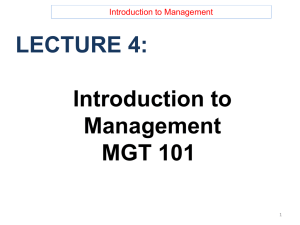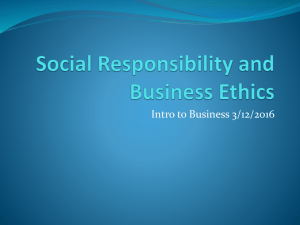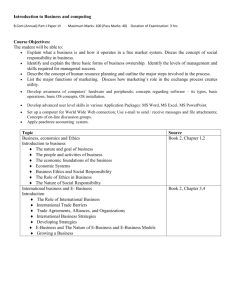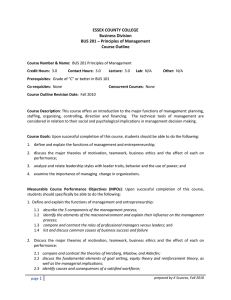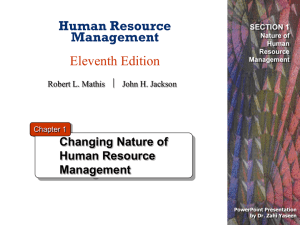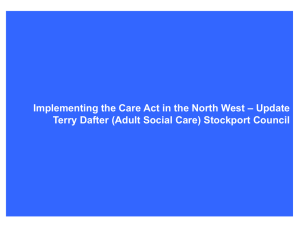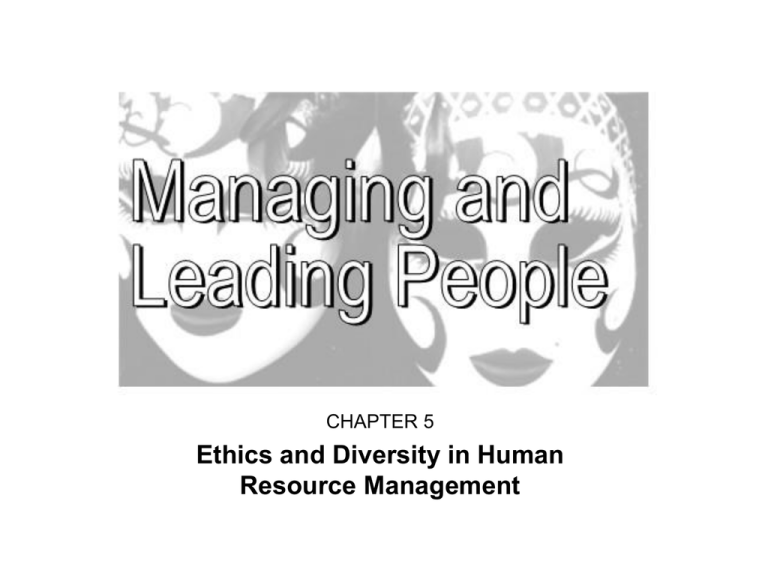
CHAPTER 5
Ethics and Diversity in Human
Resource Management
Ethics and people
What’s special about human resources?
• First, they aren’t owned by the organisation.
• Second, they choose to enter into a contract.
• That contract is often continuing in form, for a
range of reasons.
• Anyway, human beings are special, with
special rights, that must be respected.
Approaches to ethics
• Duties
– Things that must always be done (or refrained
from)
– Link to rights and principles
• Consequences
– Good or bad according to what happens as a
result
• Virtues
– Desirable character qualities
Ethics and businesses
• Businesses (and other employing
organisations) are not the same as people.
• However, they do behave with intent ...
• … and their actions do result from decisions
made by groups of individual people.
• The importance of defining clearly the
purpose of the organisation
– a key aspect of whether a corporate action is
good or bad.
Business purpose
• Some see businesses as existing to make
money for their owners, in competition with
other businesses and within the law.
• Others see businesses as having a broader set
of responsibilities to society
– The ‘corporate social responsibility’ of business.
• Interesting implications for how a business
should behave
– eg as an employer.
Codes of conduct
• Help to define desirable behaviours in
business
• May relate to organisations, sectors or
professions
• Provide a balance between aspiring to ideals
and offering relevant guidance for real-life
situations
Equal opportunities
• The equal opportunities (EO) approach stands
against unfair discrimination
– Hiring or promoting only on the basis of ability to
do a specified job
• Strong ethical justification
– Duties and consequences
• Often underpinned by legal obligations
• EO is not the same as ‘positive discrimination’
Cost/benefit perspective:
Direct costs
Indirect costs
DIVERSITY
MANAGEMENT
Direct benefits
Indirect benefits
Factors which affect international
employee performance
•
•
•
•
•
The compensation package
The task
Headquarters support
The performance environment, and
Cultural adjustment
See, for example: Dowling, P. J., Festing, M. and Engle A. D. (2008)
International Human Resource Management, 5th edition. London:
Thomson
Performance focus factors v
individual valance
Workplace diversity: a business
success factor
1. A driver for a diverse workforce?
– expansion of many large business organisations into
international, European and global markets
2. A driver for a diverse workforce?
– The (perceived) need for an ethnically/socially wellbalanced workforce
3. A driver for a diverse workforce?
– Improve and or maintain organisational ‘image’
4. A driver for a diverse workforce?
– Increases in labour mobility (perhaps linking to:)
– Changes in the supply and demand for labour
Diversity behaviours in the workplace
Source (adapted): Robbins, S. P. (2005) Organizational Behaviour, 11th edition. Harlow: Pearson/Prentice Hall; p.600

